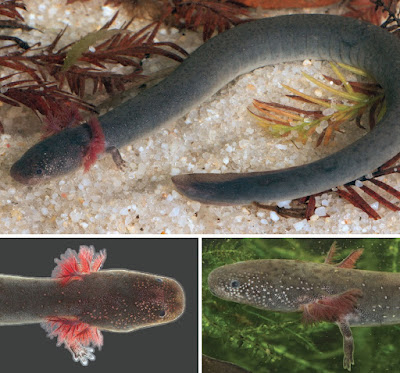 |
| Siren sphagnicola Fedler, Enge & Moler, 2023 Seepage Siren || DOI: 10.11646/zootaxa.5258.4.1 |
Abstract
For approximately four decades, scientists have known of the existence of several undescribed species of Siren in the southeastern United States Coastal Plain. One of these species, S. reticulata, was recently described, but a small, seepage-dwelling species has remained undescribed until now. To resolve outstanding questions concerning the phylogeny of Siren, we collected sequence and morphometric data from specimens across the range of Siren. We found S. lacertina and S. reticulata to represent strongly supported monophyletic groups, with S. reticulata having a sister relationship to all other Siren. Additionally, we found five distinct mtDNA lineages within what has been recognized as S. intermedia. Siren lacertina and type-locality S. intermedia (lineage A) are sister mtDNA lineages, whereas S. intermedia lineages B and C show a high level of mitogenomic divergence from type-locality S. intermedia. Analyses of two scnDNA loci revealed that S. lacertina is monophyletic but nested with low positional support in a clade including the three S. intermedia mtDNA lineages. Further study is needed to determine whether S. intermedia lineages A, B, and C represent distinct species or incompletely sorted lineages. We restrict the range of S. intermedia to the region from the Escambia and Perdido river drainages of Florida and Alabama eastward through Virginia (the combined ranges of lineages A, B, and C). We also elevate S. i. nettingi (lineage E) to species status and include the larger S. i. texana form in that taxon, generating a species that occurs from the Mobile Bay drainages westward through the Mississippi Basin and southwest into northeastern Mexico. Lastly, we describe a new miniature species, S. sphagnicola, that ranges from the Florida Parishes of Louisiana eastward to the westernmost tributary creeks of Choctawhatchee Bay in the western Florida panhandle.
Key words: Sirenidae, phylogeny, Siren sphagnicola, new species, Gulf Coastal Plain
Siren sphagnicola sp. nov.
Common name. Seepage Siren
Diagnosis. Siren sphagnicola has typical Siren characteristics: external gills with three fimbriate gill stalks, three associated gill slits, four toes on the forelimbs, lack of pelvic girdle and hindlimbs, and a thin, pigment-bearing mucus layer that overlies the keratinized skin. A combination of traits distinguishes it from other members of the genus. It has 30‒33 costal grooves (Fig. 3) and a mouse gray base color with occasionally a light, grayish brown sheen on the dorsum (Fig. 11). Small juveniles in the post-macrocephalic larval stage, which is >2 months of age according to diagrams of growth/transition rates of S. nettingi provided by Noble & Marshall (1932), have the same gray coloration as adults (Fig. 11) and lack the orange, red, or yellow highlights present on other Siren juveniles of similar age (Fig. 13). A few adult specimens examined have small, well-defined black spotting on the head and occasionally on the dorsum (Fig. 11). Sensory pits on the head are more visible than those on heads of other Siren species and are typically ivory to beige colored, which may denote an absence of gray pigment rather than the presence of chromatophores (Fig. 11). This species lacks the yellow labial stripe present in young S. lacertina (Figs. 13B & 13F), S. intermedia (Figs. 13A, 13C, 13G, & 13I), and S. nettingi examined from the Mobile Bay drainage. Some juvenile S. intermedia in eastern populations also lack the light labial stripe. A few small juvenile S. sphagnicola have yellow spots or a short, broken stripe where a labial stripe is present in other species (Figs. 13E & 13H). Siren sphagnicola also lacks the post-cranial yellow or gold flecking found in many S. lacertina (Fig. 8), S. intermedia (Fig. 10),and S. nettingi. Gill stalk coloration is typically rosy pink to red in recently captured specimens but fades to grayish pink in captivity, likely due to changes in acidity or oxygenation of water. Intact tail tips are rounded, whereas partially regenerated tails (frequently observed) often taper to an abrupt point after the tail fin blade (Fig. 11). Regenerated portions of the tail seem to lack the density of gray pigment found in non-regenerated portions; thus, the regenerated portion is easily distinguished by its pinkish gray hue. Regenerated portions of the tail of other Siren species examined match the normal body coloration or have a brownish hue.
Etymology and common name. The specific epithet is derived from Sphagnum, the generic name for sphagnum moss, and the Latin suffix -cola, meaning inhabitant or dweller. The species epithet is used as noun in apposition. This siren is frequently found in and under mats of Sphagnum in and along streams and the margins of other bodies of water. Because of its affinity for seepage-fed streams and wetlands, we suggest Seepage Siren as the common name.
Matthew T. Fedler, Kevin M. Enge and Paul E. Moler. 2023. Unraveling Siren (Caudata: Sirenidae) Systematics and Description of A Small, Seepage Specialist. Zootaxa. 5258(4); 351-378. DOI: 10.11646/zootaxa.5258.4.1




